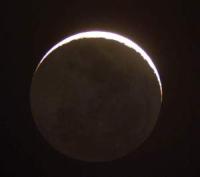 Happy New Year! The New Year 2014 begins with both a new moon and a supermoon. The month also ends with a both a new moon and and a supermoon on the 30th. A supermoon is the term applied when the moon is at perigee, the closest approach the Moon makes to the Earth on its elliptical orbit. A supermoon during a full moon will cause the moon to appear up to 16% bigger than usual. A supermoon during a new moon will, of course, not appear larger, as the moon is in the shadow of the earth during a new moon and is not visible at all. Tides are usually higher during a supermoon.
Happy New Year! The New Year 2014 begins with both a new moon and a supermoon. The month also ends with a both a new moon and and a supermoon on the 30th. A supermoon is the term applied when the moon is at perigee, the closest approach the Moon makes to the Earth on its elliptical orbit. A supermoon during a full moon will cause the moon to appear up to 16% bigger than usual. A supermoon during a new moon will, of course, not appear larger, as the moon is in the shadow of the earth during a new moon and is not visible at all. Tides are usually higher during a supermoon.
According to Earth Sky: “..The year 2014 will have five supermoons: two January new moons, and the full moons of July, August and September. The full moon on August 10, 2014, is the closest supermoon of the year (356,896 kilometers or 221,765 miles).
However, the new moons on January 1 and January 30 will not be all that far behind, featuring the year’s second-closest and third-closest supermoons, respectively. On January 1, the moon turns new approximately 10 hours before reaching lunar perigee – the moon’s closest point to Earth in its orbit. On January 30, the moon turns new nearly 12 hours after reaching lunar perigee.”
